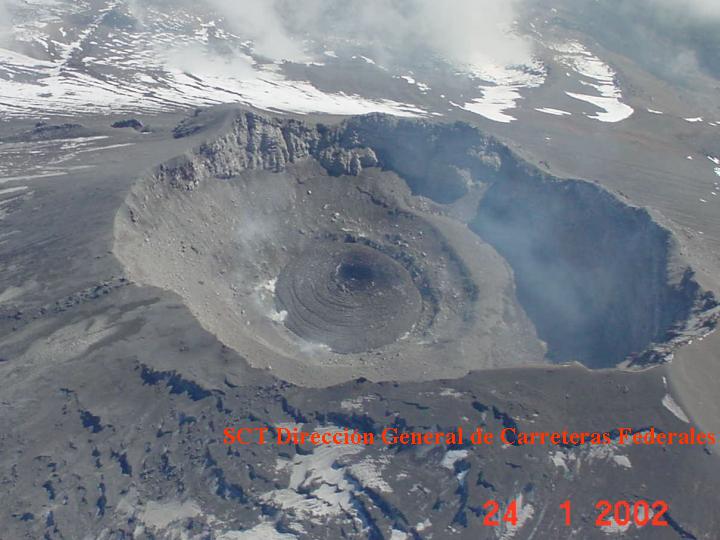MICHAEL MANGA
EPS 214: Physical Volcanology

Image of the month: New dome is forming in Popocatepetl's summit crater
(from Dan Shackelford)
"The diameter of the new dome is 180 m and is 50 m high. This is
aproximately 20 times less compared to the dome formed during December
2000."
Syllabus
This course provides an overview of the physical aspects of volcanic
and magmatic processes. No prerequisites, but previous courses in igneous
petrology and calculus through differential equations will be very helpful.
Meeting time:
This class meets Tuesdays and Thursday from 9:30-11:00, McCone 365;
the lab time will be arranged.
Texts:
``Encyclopedia of Volcanoes'' edited by Bruce Houghton, Stephen
McNutt, Hazel Rymer, John Stix. This volume provides a recent (published
2000) and comprehensive overview of almost all aspects of volcanology.
Unfortunately, each chapter provides a list of Further Reading rather
than true references and citations. This book is available in the Earth
Science library reference section; the retail price is $99.95.
We will supplement the Encyclopedia with research papers, typically
2-6 per week.
The next time this class is taught (possibly fall 2003 or
spring 2004), we will use Volcanic Processes by Flavio Dobran
(2001).
Labs:
There will be five prepared labs in addition to the group or class project.
These labs involve examining thin sections of volcanic rocks in order to
deduce the rate and nature of magmatic and volcanic processes. You will
also notice that the labs bear to direct connection to the topics covered
in lecture. Check out this web site for nice pictures of thin sections:
UNC
Igneous Petrology Atlas
-
Emplacement time of Obsidian Dome, Long Valley, California Lab
1
-
Determining flow type from microstructures Lab
2
-
Crystallization and permeability development in Hawaiian basalts
Lab
3
-
Textural characteristics of pumice
Lab
4
-
What can bands in Obsidian tell us?
Lab
5
Field trip: Sometime in May we will go to Long Valley in Eastern CA and
look at Obsidian flows. The purpose of the trip is to combine what we learned
in the lab with field observations in order to learn more about Obsidian
flow dynamics. See the following USGS website for more information about
the Long Valley region: Long
Valley Observatory
Tentative outline
Page numbers refer to pages in the Encyclopedia. Supplementary
reading will be assigned in class.
Week 1
-
History of Volcanology (pp. 15-37)
-
Supplemental reading: Frank Dawson Adams, "The Birth and Development
of the Geological Sciences", 1938, reprinted by Dover 1954
-
Sizes and rates of eruption (pp. 249-281)
-
Additional reading (available in class): Gardner et al., GSA Bulletin,
110:
173-187 (1998)
-
In you are interested in the current eruption in Congo (ex-Zaire), here
are three papers about Nyiragongo volcano that cover a range of topics:
Oppenheimer (1998) Satellite observations of lava lake activity at Nyira
ex-Zaire, during the Rwandan refugee crisis, Disasaters, 22:
268-281; Demant et al. (1994) Volcanological and petrological evolution
of Nyiragongo volcano, Virunga volcanic field, Zaire, Bull. Volc.,
56:
47-61; Hamaguchi et al. (1992) Process of the 1977 Nyiragongo eruption
inferred from the analysis of long-period earthquakes and volcanic tremors,
Tectonophysics,
209:
241-254.
Weeks 2-3
-
Melting the mantle (pp. 55-68)
-
Properties of magmas (pp. 89-190)
Week 4
-
Migration of melt (pp. 69-88)
-
Additional reading: Richardson, Geophys. Res. Lett., 25:
1099-1102 (1998); Stevenson and Scott, Ann. Rev. Fluid Mech., 23:
305-339 (1991); Zimmerman et al., Geophys. Res. Lett., 26:
1505-1508 (1999)
Week 5-6
-
Magma chambers and calderas (pp. 191-248, 643-662)
-
McLeod, Geophys. Res. Lett., 27: 739-742 (1999)
Weeks 7-9
-
Lava flows (pp. 283-420)
-
Cashman et al., Bull. Volc., 61: 306-323 (1999); Hon et al.,
Geol.
Soc. Am. Bull., 106: 351-370 (1994); Self et al., Ann. Rev.
Earth Planet. Sci., 26: 81-110 (1998); Melnik and Sparks,
Nature,
402: 37-41 (1999)
Week 10-11
-
Fragmentation (pp. 421-430)
-
Navon and Lyakhovsky, in Physics of Explosive Eruptions, edited
by Gilbert and Sparks, Geol. Soc. Lond. sepcial pub., 145: 27-50; Papale,
Nature, 397: 425-428 (1999); Sahagian, Nature,
402:
589-591 (1999); Alidibirov and Dingwell, J. Volc. Geotherm. Res.,
100: 413-421 (2000); Marti et al., Nature,
402: 650-653
(1999); Zhang, Nature,
402: 648-650 (1999); Hort and Gardner,
J. Geophys. Res., 105: 25,981-26,001 (2000)
Week 12-13
-
Strombolian, Vulcanian and Plinian eruptions (pp. 447-494; 1015-1034)
-
Vergniolle and Brandeis, Geophys. Res. Lett., 18: 195-199
(1994); Clarke et al., Nature, 415: 897-901 (2002); Morrisey
and Chouet, Science, 275: 1290-1293 (1997); Villemant and
Boudon, Nature, 392: 65-69 (1998)
Week 14
-
External water and eruptions (pp. 431-446, 495-526)
Weeks 15-16
-
Volcanic plumes and fall deposits (pp. 527-600, 663-695)
Useful links
Last modified 31 January 2002

Stretched bubble (about 100 microns long) in obsidian;
from its shape we can infer both the flow type and strain rate
(from work with graduate student Alison Rust)
Return to Michael's
home page


